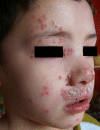Recent insights into atopic dermatitis and implications for management of infectious complications
- PMID: 20109729
- PMCID: PMC2814072
- DOI: 10.1016/j.jaci.2009.11.027
Recent insights into atopic dermatitis and implications for management of infectious complications
Abstract
Atopic dermatitis (AD) is a common complex disease that frequently follows a chronic relapsing course and affects the quality of life of patients and families in a significant manner. New insights into the pathophysiology of AD point to an important role of structural abnormalities in the epidermis combined with immune dysregulation. Patients with AD have a unique predisposition to colonization or infection by a number of microbial organisms, most notably Staphylococcus aureus and herpes simplex virus. A multipronged approach directed at healing or protecting the skin barrier and addressing the immune dysregulation is necessary to improve the likelihood of successful outcomes.
Copyright 2010 American Academy of Allergy, Asthma & Immunology. Published by Mosby, Inc. All rights reserved.
Figures
References
-
- Boguniewicz M, Schmid-Grendelmeier P, Leung DYM. Clinical Pearls: Atopic dermatitis. J Allergy Clin Immunol. 2006;118:40–3. - PubMed
-
- Laughter D, Istvan JA, Tofte SJ, Hanifin JM. The prevalence of atopic dermatitis in Oregon schoolchildren. J Am Acad Dermatol. 2000;43:649–5. - PubMed
-
- Williams H, Stewart A, von Mutius E, Cookson W, Anderson HR, International Study of Asthma and Allergies in Childhood (ISAAC) Phase One and Three Study Groups Is eczema really on the increase worldwide? J Allergy Clin Immunol. 2008;121:947–54. - PubMed
-
- Odhiambo JA, Williams HC, Clayton TO, Robertson CF, Asher MI, ISAAC Phase Three Study Group Global variations in prevalence of eczema symptoms in children from ISAAC Phase Three. J Allergy Clin Immunol. 2009 in press. - PubMed
Publication types
MeSH terms
Grants and funding
LinkOut - more resources
Full Text Sources
Other Literature Sources
Medical



